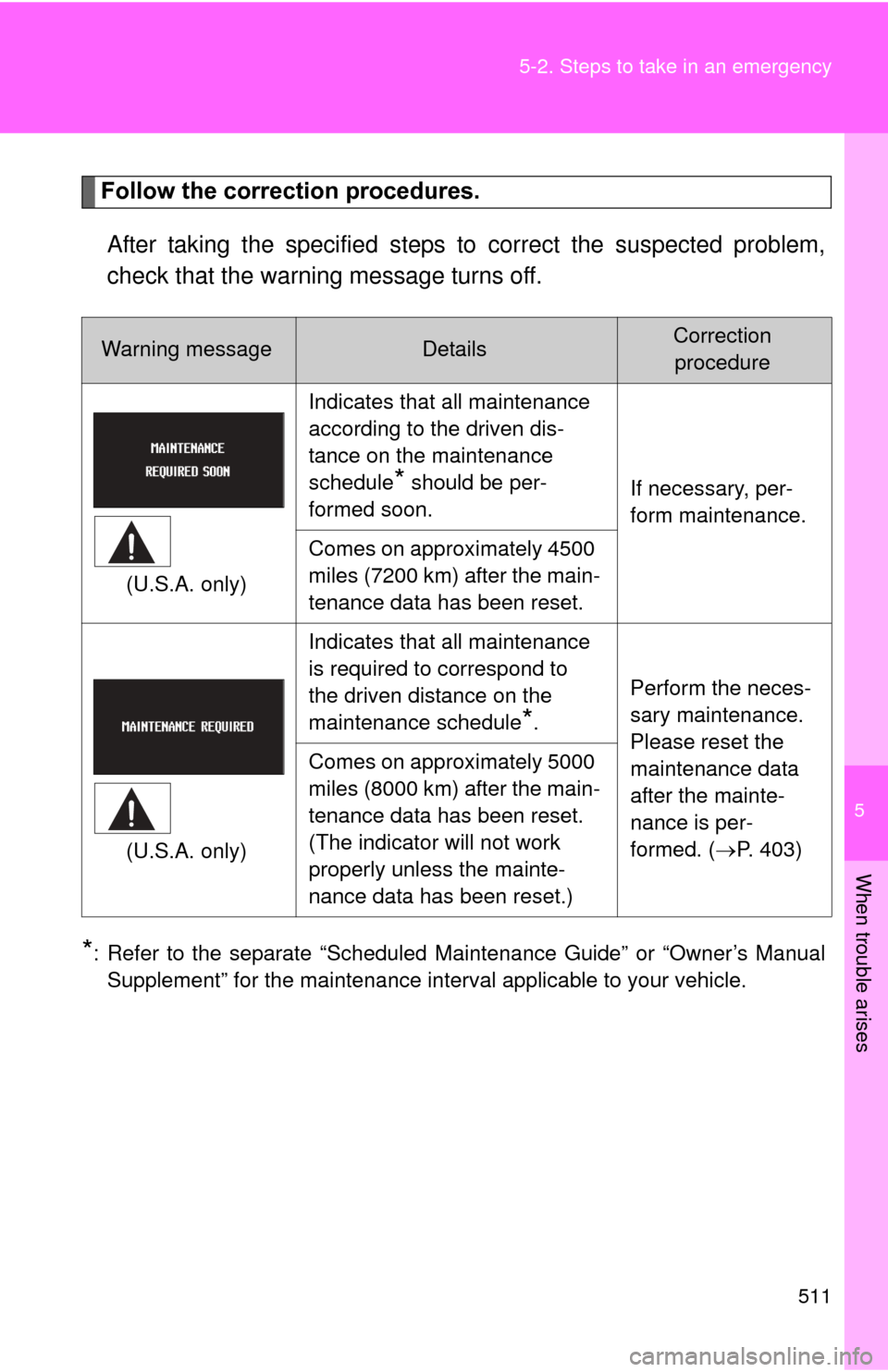Page 505 of 636

5
When trouble arises
505
5-2. Steps to take in an emergency
CAUTION
As an added safety feature, your
vehicle has been equipped with a tire
pressure monitoring system (TPMS-ti re pressure warning system) that
illuminates a low tire pressure telltal e (tire pressure warning light) when
one or more of your tires is significantly under-inflated. Accordingly,
when the low tire pressure telltale (tire pre ssure warning light) illumi-
nates, you should stop and check your tires as soon as possible, and
inflate them to the proper pressure. Driving on a significantly under-
inflated tire causes the tire to overheat and can lead to tire failure.
Under-inflation also reduces fuel effi ciency and tire tread life, and may
affect the vehicle’s handling and stopping ability.
Please note that the TPMS (tire pressure warning system) is not a sub-
stitute for proper tire ma intenance, and it is the driver’s responsibility to
maintain correct tire pressure, even if under-inflation has not reached the
level to trigger illu mination of the TPMS low tire pressure telltale (tire
pressure warning light).
Your vehicle has also been equipped with a TPMS (tire pressure warning
system) malfunction indicator to indi cate when the system is not operat-
ing properly. The TPMS (tire pressure warning system) malfunction indi-
cator is combined with the low tire pressure telltale (tire pressure
warning light). When the system det ects a malfunction, the telltale will
flash for approximately one minute an d then remain continuously illumi-
nated. This sequence will continue upon subsequent vehicle start-ups as
long as the malfunction exists. When the malfunction indi cator is illumi-
nated, the system may not be able to detect or signal low tire pressure
as intended.
Page 511 of 636

5
When trouble arises
511
5-2. Steps to take in an emergency
Follow the correction procedures.
After taking the specified steps to correct the suspected problem,
check that the warning message turns off.
*: Refer to the separate “Scheduled Maintenance Guide” or “Owner’s Manual Supplement” for the maintenance interval applicable to your vehicle.
Warning messageDetailsCorrection procedure
(U.S.A. only) Indicates that all maintenance
according to the driven dis-
tance on the maintenance
schedule
* should be per-
formed soon. If necessary, per-
form maintenance.
Comes on approximately 4500
miles (7200 km) after the main-
tenance data has been reset.
(U.S.A. only) Indicates that all maintenance
is required to correspond to
the driven distance on the
maintenance schedule
*.
Perform the neces-
sary maintenance.
Please reset the
maintenance data
after the mainte-
nance is per-
formed. (
P. 403)
Comes on approximately 5000
miles (8000 km) after the main-
tenance data has been reset.
(The indicator will not work
properly unless the mainte-
nance data has been reset.)
Page 581 of 636

581
6-1. Specifications
6
Vehicle specifications
■
Traction AA, A, B, C
The traction grades, from highest to lowest, are AA, A, B and C,
and they represent the tire’s ab ility to stop on wet pavement as
measured under controlled cond itions on specified government
test surfaces of asphalt and concrete.
A tire marked C may have poor traction performance.
Warning: The traction grade assigned to this tire is based on braking
(straight ahead) traction tests and does not include cornering (turn-
ing) traction.
■ Temperature A, B, C
The temperature grades are A (the highest), B, and C, represent-
ing the tire’s resistance to the generation of heat and its ability to
dissipate heat when tested under controlled conditions on a speci-
fied indoor laboratory test wheel.
Sustained high temperature can cause the material of the tire to
degenerate and reduce tire life, and excessive temperature can lead
to sudden tire failure.
Grade C corresponds to a level of performance which all passenger
car tires must meet under the Federal Motor Vehicle Safety Standard
No. 109.
Grades B and A represent higher levels of performance on the labo-
ratory test wheel than the minimum required by law.
Warning: The temperature grades of a tire assume that it is properly
inflated and not overloaded.
Excessive speed, underinflation, or excessive loading, either sepa-
rately or in combination, can caus e heat buildup and possible tire fail-
ure.
Page 630 of 636
630
What to do if...
What to do if...
A tire puncturesP. 523If you have a flat tire
The hybrid system does not start
P. 538If the hybrid system will not start
P. 135Immobilizer system
P. 543If the 12-volt battery is
discharged
The high coolant temperature
warning light flashes or comes on
“HYBRID SYSTEM OVERHEAT”
is displayed
Steam can be seen coming
from under the hood
P. 549If your vehicle overheats
The key is lostP. 540If you lose your keys
The 12-volt battery runs outP. 543If the 12-volt battery is
discharged
The doors cannot be lockedP. 8 7Side doors
P. 9 3Back door
The vehicle is stuck in mud or
sandP. 554If the vehicle becomes stuck
A warning light or indicator
light comes onP. 493If a warning light turns on or a
warning buzzer sounds